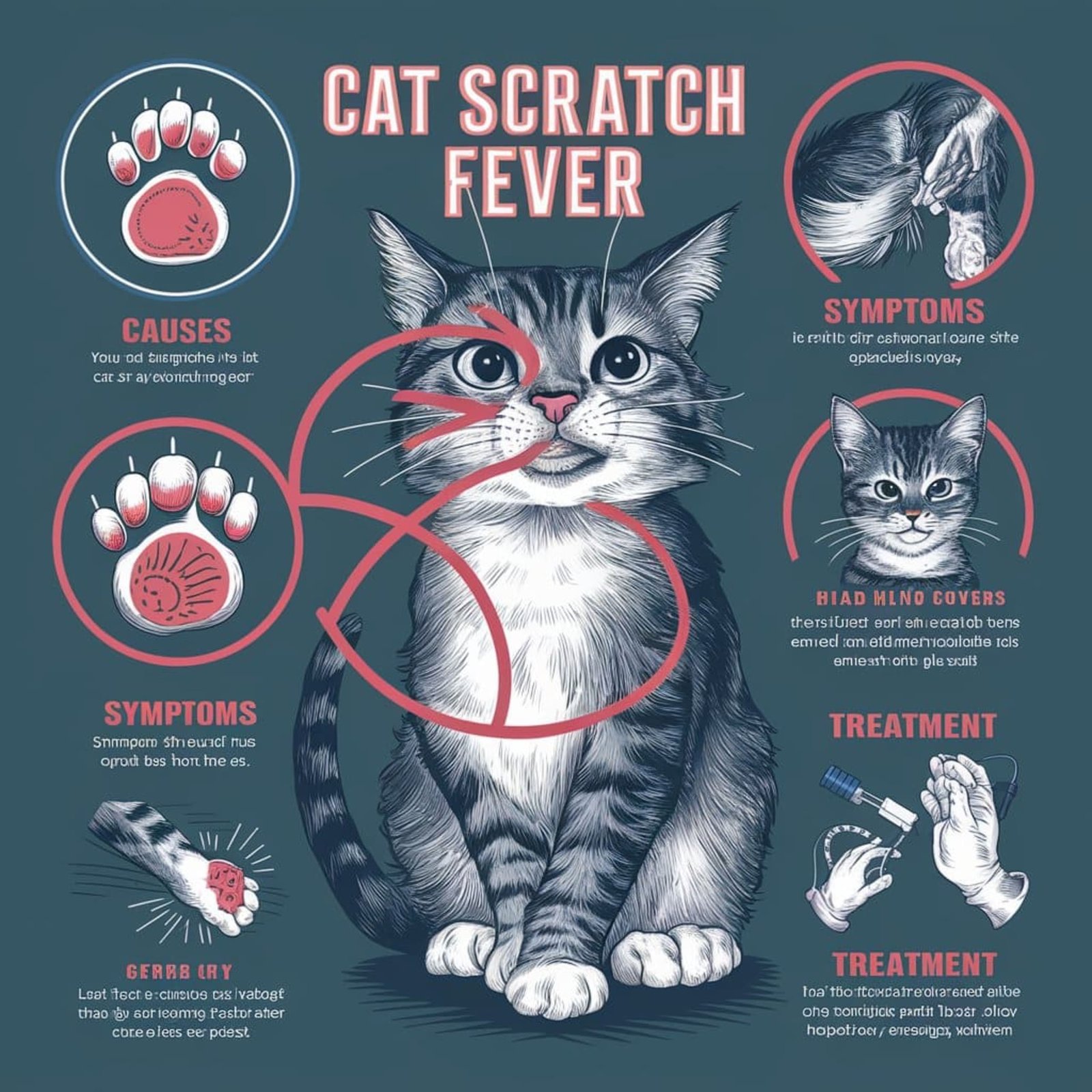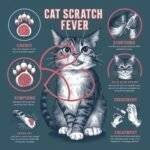Cat scratch fever, also called cat scratch disease, is a bacterial infection. It comes from the Bartonella henselae bacteria. This disease can be transmitted to humans from infected cats through scratches, bites, or contact with their saliva. It’s important to know the causes, signs, and how to treat this serious illness.

Key Takeaways
- Cat scratch fever is a bacterial infection caused by Bartonella henselae, which is transmitted through contact with infected cats.
- Symptoms include lymph node swelling, fever, and other flu-like symptoms, which typically appear 3-14 days after exposure.
- Risk factors include owning a cat, especially a kitten, and exposure to cats through scratches, bites, or contact with saliva.
- Diagnosis involves a medical history, physical examination, and laboratory tests to confirm the presence of the Bartonella henselae bacteria.
- Treatment usually involves antibiotic therapy, and most patients recover within 2-4 months with proper medical care.
Understanding Cat Scratch Fever
Cat scratch fever, also known as cat scratch disease, is a zoonotic bacterial infection. It is caused by the Bartonella henselae bacteria. This illness spreads from cats to humans through scratches, bites, or touching infected saliva. It’s important to know about this to keep cats and humans healthy.
What is Cat Scratch Fever?
Cat scratch fever is a bacterial infection that humans can get from cats. It happens when people get scratched or bitten by an infected cat, or touch its saliva. The bacteria Bartonella henselae are present in many healthy cats. They can cause cat scratch fever in humans.
Causes: Bartonella henselae Bacteria
The Bartonella henselae bacteria cause cat scratch fever. They are found in cats’ claws and saliva. When a person is scratched, bitten, or comes into contact with the saliva of an infected cat, they can contract the bacteria. This leads to cat scratch disease.
| Bacteria | Transmission | Infection |
| Bartonella henselae | Cat scratches, bites, or contact with saliva | Cat scratch fever |

“Cat scratch fever is a relatively common zoonotic disease that can be prevented through proper hygiene and responsible pet care.”
Symptoms of Cat Scratch Fever
The main signs of cat scratch fever are lymph node swelling and fever. These signs show up when a person gets infected with the Bartonella henselae bacteria. Other symptoms can also appear, and knowing them helps in getting medical help if needed.
Lymph Node Swelling and Fever
The key symptoms are swollen lymph nodes and fever. These start within 3-14 days after touching the bacteria. The swollen lymph nodes are usually near where the cat scratched or bit you. Sometimes, the fever brings chills and headaches.
Additional Symptoms to Watch For
In addition to swollen lymph nodes and fever, cat scratch fever can lead to other complications. Some folks might feel fatigue, lose their appetite, and get headaches. Rarely, serious problems like eye inflammation (Parinaud’s oculoglandular syndrome) or neurological problems can happen.
If you notice strange symptoms, especially after touching a cat, see a doctor. Getting help early can stop the illness from getting worse and lessen the chance of serious issues.

| Symptom | Description |
|---|---|
| Lymph Node Swelling | The lymph nodes closest to the site of the cat scratch or bite become swollen and tender. |
| Fever | Fever is a common symptom, often accompanied by chills and headaches. |
| Fatigue | Some people experience fatigue and loss of appetite. |
| Eye Inflammation | In rare cases, Parinaud’s oculoglandular syndrome can cause eye inflammation. |
| Neurological Problems | Rarely, cat scratch fever can lead to neurological complications. |
Cat Scratch Fever: Risk Factors
Owning a cat comes with risks, like getting cat scratch fever, a disease from the Bartonella henselae bacteria. It’s important for pet owners and those who often touch cats to know the risks. This disease is transmitted from cats to humans.
One big risk is not keeping your cat clean. Regular grooming, vet visits, and a clean home for your cat can lower disease risk. Also, avoid getting scratched or bitten by your cat as much as possible. These are main ways the disease spreads.
Cat age and health also matter. Kittens and older cats might carry the bacteria more easily. People with weak immune systems, like those with HIV/AIDS, cancer, or organ transplants, are more likely to get very sick from the disease.
- Inadequate cat hygiene and grooming
- Exposure to cat scratches or bites
- Owning a kitten or an older cat
- Weakened immune system or underlying health conditions
Knowing these risks and caring for your pet well can lower your chance of getting cat scratch fever. This way, you and your cat can enjoy a healthy life together.
Diagnosing Cat Scratch Fever
Diagnosing cat scratch fever, also known as febrile illness or lymphadenopathy, is a detailed process. It looks at symptoms, medical history, and lab results. The process starts with a medical history and physical check-up. Then, lab tests confirm the diagnosis.
Medical History and Physical Examination
The first step is a detailed medical history and a full physical check-up. Doctors ask about symptoms like fever, lymph node swelling, and contact with cats or scratches. They look for regional lymphadenitis or signs of bacterial infection during the exam.
Laboratory Tests for Confirmation
To confirm cat scratch fever, doctors may run several lab tests, including:
- Blood tests for atypical lymphocytosis and Bartonella henselae antibodies
- A biopsy of the affected lymph node to check for granulomas and rule out other causes
- Imaging tests like ultrasound or CT scans to see how much lymph nodes are affected and to rule out other conditions
Doctors also look for Parinaud’s oculoglandular syndrome in some cases. This is swelling of the lymph nodes near the eye in people with cat scratch fever.
By using a detailed medical history, physical check-up, and specific lab tests, doctors can accurately diagnose cat scratch fever. This enables them to develop an effective treatment plan.
Treatment Options for Cat Scratch Fever
Managing cat scratch fever often means using antibiotics and supportive care together. The main goal is to treat the Bartonella henselae infection and ease symptoms.
For mild cases, cat scratch fever might get better on its own. But for severe or ongoing cases, antibiotic treatment is usually needed. This helps get rid of the cat scratch bacteria and aid in recovery.
Common antibiotics for feline-associated zoonosis include:
- Azithromycin
- Doxycycline
- Ciprofloxacin
Along with antibiotic treatment, doctors may suggest supportive care. This helps manage symptoms and support feline health. Supportive care can include:
- Applying warm compresses to swollen lymph nodes
- Taking over-the-counter pain medication to manage discomfort
- Resting and allowing the body to heal
The treatment length and specifics can vary by case and infection severity. It’s key to follow up with a healthcare provider regularly. This ensures a full recovery and helps prevent complications.
| Antibiotic | Typical Dosage | Duration of Treatment |
|---|---|---|
| Azithromycin | 500 mg once daily | 5-10 days |
| Doxycycline | 100 mg twice daily | 14-21 days |
| Ciprofloxacin | 500 mg twice daily | 7-10 days |
“Prompt and appropriate treatment is essential in managing cat scratch fever and preventing potential complications.”
Conclusion
This article has given a full look at cat scratch fever, a bacterial infection from Bartonella henselae bacteria. It spreads through contact with cats. We’ve covered the main points on this feline-associated zoonotic disease.
By focusing on proper hygiene and responsible pet care, cat owners can lower the risk of cat scratch fever. The article highlighted the key signs like lymph node swelling, fever, and other symptoms. It also stressed the need for quick medical help and the right antibiotic treatment.
This guide aims to educate and empower readers. It gives them the knowledge to handle cat scratch fever well. By taking preventative measures, cat owners can help keep their pets and communities healthy.
FAQ
What is cat scratch fever?
Cat scratch fever is a bacterial infection. It comes from the Bartonella henselae bacteria. People get it from cats through scratches, bites, or touching the cat’s saliva.
What are the common symptoms of cat scratch fever?
Common symptoms include swollen lymph nodes and a fever. People may also feel tired, have headaches, and in rare cases, eye inflammation or neurological issues.
Who is at risk of getting cat scratch fever?
Cat owners, those scratched or bitten by a cat, and those in close contact with a cat’s saliva are at higher risk. Keeping clean and caring for pets properly can lower the risk of getting this disease.
How is cat scratch fever diagnosed?
Doctors use a detailed medical history, physical check-up, and lab tests like blood tests and biopsies. These help confirm the infection and rule out other possible causes.
How is cat scratch fever treated?
Treatment usually involves antibiotics to fight the infection. It’s important to get support and watch over the patient to help them recover well.






[…] bettas, stay away from aggressive fish. Good friends for bettas are calm, small fish like corydoras cat-fish, tetras, or rasboras. Add lots of hiding spots and plants to help them feel safe and less […]
[…] Hamsters come in a variety of species, each with its own distinct characteristics and care requirements. […]
[…] Maine Coon is a large domestic cat known for its semi-longhair coat and gentle nature. It has won the hearts of cat lovers worldwide. […]